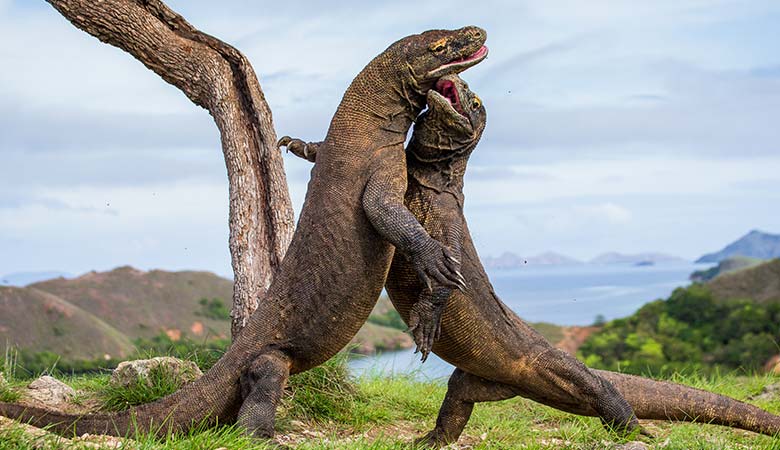Little Lizardfolk (5e Race)

|
|---|
Little Lizardfolk[edit]
"Not very much unlike a regular lizard, but this one will have the decency of cleaning after itself... with proper training."
Physical Description[edit]

|
|---|
| A pair of twins wrestling while the master is away on a errand. |
Generally referred to as "Diminutive Lizard Folk" in academic circles, most common people refer to them as biped monitors. Generally having softer features than regular Lizardfolk, with no pointy growths, fine scales that offer little to no protection and usually never grow longer than 6 feet from head to tail, and 3 feet standing upright.
History[edit]
On a rare occurrence of a small egg to be laid after the matting season, these eggs are almost every time thrown away by the tribe, as the hatchlings normally die off in the first days and are not worth the time and resources. On lucky occasions the egg gets picked up by someone of the civilized people and kept as a memento or hatched out of curiosity. Generally perceived as an exotic pet, most of them are kept in closed places for the entertainment of the owner. But on some occasions the finder of the egg will take a parental role towards the little one and give them a proper life, some even educating them into civilized culture.
Attitudes and Beliefs[edit]
Like the normal Lizardfolk, the diminutive ones have the same reptilian mind, not really being emotional, but if they are raised in a parental space they usually develop a few quirky stand ins for emotions, similar to how human children do goofy imitations of their parents. Little Lizardfolk normally pick up the tendencies and beliefs of their master/parents, as they very often take to learn their craft in a very methodical way. A warrior or scholar that adopts a little one will almost every time have a smaller version of themselves following them around. As such, the little ones can be found in any part of the alignment chart.
Little Lizardfolk Names[edit]
As most of the little ones are always found in civilized races societies, they tend to either have pet names or proper names in the case they are born to a caring person. (I'm not really good at coming up with names, anyone who has a good idea for names that'd fit, please add them)
Little Lizardfolk Traits[edit]
| A sub type of Lizardfolk, normally thrown out because of expectation of the hatchling dying anyway. The ones that survive are the lucky few that are found by an adventurer and get hatched. Ability Score Increase. Your Wisdom and Charisma scores are each increased by 1. Age. Their physical size is not the only small thing about them - they tend to become mature by the age of 6 and most of them live up to 35 human years. Usually developing bad diseases and conditions in their final years. Alignment. Little Lizardfolk tend to emulate their adoptive parent's tendencies and beliefs, as such they don't have a specific alignment to gravitate towards. You have the same chance to meet a lawful good one as you do meeting a chaotic evil one. Size. They tend to be at most 3 feet tall, standing. Your size is Small. Speed. Your base walking speed is 25 feet, and you have a swimming speed of 30 feet. |
| Bite. Your fanged maw is a natural weapon, which you can use to make unarmed strikes. If you hit with it, you deal piercing damage equal to 1d4 + your Strength modifier, instead of the bludgeoning damage normal for an unarmed strike. |
| Hold Breath. You can hold your breath for up to 15 minutes at a time. |
| House Culture. You gain proficiency with two of the following skills of your choice: Performance, Insight, Perception, Deception, Persuasion. |
| Stress Eating. Once per short rest, whenever your hit points drop below half the max number, you can unleash your survival instinct as to make sure you will overcome the situation. As a bonus action, you can make
a special attack with your bite. If the attack hits, it deals its normal damage, and you gain temporary hit points (minimum of 1) equal to your Constitution modifier, |
| Resident. Like their savage brethren, the little ones tend to be very inventive with their surroundings. When resting in a civilized area, lived or abandoned, they will craft a random item (discuss with DM how to decide the item). Appropriate tools are required for this to be possible. |
| Languages. You can speak, read, and write Common and Draconic. |
Random Height and Weight[edit]
| Base Height |
Height Modifier* |
Base Weight |
Weight Modifier** |
|---|---|---|---|
| 2′ 6'' | +1d4 | 120 lb. | × (1d4) lb. |
|
*Height = base height + height modifier | |||
Back to Main Page → 5e Homebrew → Races

